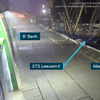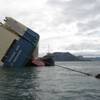Coast Guard Completes Investigation of Oil Spill
The Coast Guard has completed the investigation into the cause of the oil spill from the Greek tanker Athos I that occurred on the Delaware River on the evening of Nov. 26, 2004. Coast Guard investigators concluded that the vessel came in contact with a submerged anchor while maneuvering through Anchorage #9 enroute to its berth at the Citgo Asphalt Refining Facility in Paulsboro, N.J. The anchor punctured the vessel’s bottom plating in a ballast tank and a cargo tank, resulting in the release of nearly 264,000 gallons of crude oil.
Following the incident, surveys of the river bottom in the vicinity of the casualty were conducted by the Army Corps of Engineers and commercial surveyors contracted by the vessel’s owner. The surveys revealed numerous submerged objects in the area, including a large concrete block and a pump casing. The vessel actually struck all three of these objects; however, analysis of paint chips and the unique shape and dimensions of the hull damage revealed the anchor as the source of the puncture.
"There was no evidence that any violation of applicable international rules, Federal law or regulations contributed to this incident," said Capt. David Scott, Commander of Coast Guard Sector Delaware Bay. "The vessel came up river with a draft of 36 feet 6 inches. Our investigator’s review of the vessel’s voyage management plan indicated that appropriate calculations were made to ensure adequate under keel clearance for the prevailing 40-foot channel depth."
Coast Guard investigators were unable to determine the owner of the 18,000 pound anchor, nor establish how long it was submerged in Anchorage #9. "Evidence suggests the anchor may have been lodged in the vessel for a brief time," Scott said, "therefore we were not able to determine its precise location, nor its orientation before coming in contact with the vessel."
Because bottom surveys conducted subsequent to the incident revealed numerous submerged objects in that area, the Coast Guard has recommended that navigation guidelines currently in effect for the Delaware River be reviewed to ensure they remain appropriate. "In addition, we’ve also recommended that legislation be adopted that requires immediate reporting to the Coast Guard of any objects that have been lost or discarded into a navigable channel or anchorage that can impede safe navigation," said Scott.
The active spill clean up of nearly 57 miles of shoreline in Pennsylvania, New Jersey and Delaware was concluded just last month. "We will continue to monitor the affected areas, and are prepared to take appropriate action in the event any residual Athos I related oil is detected in the future," Scott noted. More than 18,000 tons of oily solids were removed in the clean up. Cost of the clean-up is estimated to exceed $150 million.






